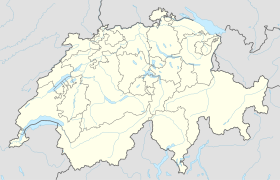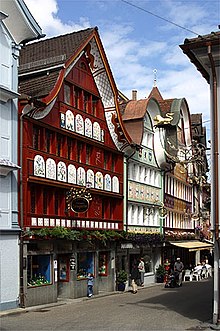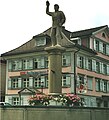Appenzell (place)
| Appenzell | ||
|---|---|---|
| State : |
|
|
| Canton : |
|
|
| District : |
Appenzell Schwende Rüte |
|
| Postal code : | 9050 | |
| Coordinates : | 748 902 / 244081 | |
| Height : | 778 m above sea level M. | |
| Residents: | 5751 (December 31, 2006) | |
| Website: | www.appenzell.org | |
|
Aerial view of Appenzell |
||
| map | ||
|
|
||
The village of Appenzell in the eastern Swiss local dialect Appezöll [ˌapːə'tsœlː] is the capital of the Swiss canton of Appenzell Innerrhoden . The place is at 780 m above sea level. M. at the foot of the Alpstein massif .
administration
Territorially, the village of Appenzell is part of the districts (political communities) Appenzell , Schwende and Rüte , with most of the village belonging to the district of Appenzell.
Because it belongs to different districts, a special community was founded as early as the 16th century for cross-community tasks such as building police, fire brigade or water and energy supply, the fire show community , which encompasses the entire village of Appenzell including its suburbs.
Surname
Appenzell, in the High Alemannic local dialect Appezöll with an emphasis on the last syllable, was first mentioned in 1071 in the form of Abbacella . Other early, but learned Latinized, testimonies are 1223 de Abbatiscella and 1244 in Abbatis Cella . The place name is a combination of Old High German abbat "abbot" and Old High German zëlla "cell, chapel; Storage, collection point for taxes, farm yard "and thus means" farm yard of the St. Gallen monastery, regional office for the natural goods tax levied by the landlord (abbot) in the inner part of the country ".
tourism
Appenzell is the tourist center of the Appenzellerland and the starting point for hikes into the Alpstein region from the north.
traffic
Narrow-gauge railways and main roads lead from Gossau , Altstätten and St. Gallen to Appenzell. There are train connections via Herisau to Gossau (with connection to Zurich ), via Gais to St. Gallen and in the direction of Alpstein to Wasserauen . There are postbus courses to Haslen - Teufen and Eggerstand.
Attractions
Townscape

The townscape of Appenzell is shaped by the buildings from the time after the fire of 1560. Wooden houses, some of which are brightly painted with curved or broken gables, give it its special character, which is most originally conveyed by the rows of houses in the Hauptgasse. Typical of the local style are the “Kreuz” and “Raben” houses on Hauptgasse and the closed group of houses at Gasthaus Falken on Gaiserstrasse. The Landsgemeindeplatz with the judicial linden tree is irregularly bounded by high and low buildings.
Church buildings
The Catholic parish church of St. Mauritius stands on an elevated point above the left bank of the Sitter River . The west tower, the polygonal choir and the crypt were built around 1513, partly after 1560. The nave by Enoch Breitenmoser dates back to 1823. The interior houses a wide classical nave with double galleries. The high altar from 1622 is the work of Bartholomäus Cades , the neo-baroque ceiling paintings were created by Franz Vettiger in 1891. The late Gothic choir shows wall and vault paintings from the 16th, 17th and 18th centuries, including a view of the village from around 1620 by Moritz Girtanner .
The reformed church was built in the years 1908-1909 by La Roche and Stähelin.
The Holy Cross Chapel, built in the late Gothic style in 1561, stands on Hauptgasse; a replacement building for the chapel which was destroyed in a village fire in 1560. The Chapel of the Holy Cross was consecrated in honor of the Holy Cross and the Fourteen Holy Helpers . The entrance portal from 1787 is made of sandstone. The Stations of the Cross from 1787 are by J. A. Füxli. The chapel was restored in 1892 and 1964/65. The baroque wooden benches originally come from the St. Magdalena Chapel, Steinegg, and were installed in 1949. In 1964 Ferdinand Gehr produced the glass painting cycle with the five secrets of the painful rosary .
At the western entrance to the village is the Capuchin Monastery of the Virgin Mary, founded between 1586 and 1587. The monastery church was rebuilt in 1688, the monastery received a new building by Hans Burkard in 1925 . The interior of the church houses early baroque altars. On the high altar is a deposition from the cross by Giulio C. Procaccini from 1605, on the right side altar a Madonna with saints from the years 1610–1620 and on the left side altar Mary Candlemas, created in 1935 by Johann Hugentobler . The monastery was closed at the end of August 2011 and the building was returned to the canton of Appenzell Innerrhoden.
The Capuchin Convent Maria the Angels is south of the main street. The church was built in the late Renaissance style in 1621/22 by the Misox masters Giovanni Altern and Andrea Toscano . The interior of the church contains a cased barrel. The monastery buildings were built by Jost Mosbrugger and Christian Zünd in 1679–1682 based on a model by Father Marquard Imfeld. The monastery was closed in April 2008; the buildings were given to a foundation.
In the western district of Rinkenbach is the St. Anton chapel, built in 1661, with an early baroque high altar from 1666 and a pulpit in cartilage style from 1673 . The side altars are from the 18th century.
North of the village, on the Steig in Mettlen, is the St. Karl chapel, built in 1620.
In the Sonnenhalb district, south of Appenzell, is the Maria in Sonnenhalb chapel. This was built in 1796 and rebuilt in 1861. The altar is in a rural late Baroque style with a Gothic Pietà around 1400 in the "soft" style.
The Lourdes Chapel is located between the Sitter and the Bleichwäldibach .
Secular buildings
The town hall is a late Gothic building from the years 1561–1563 by Hans Bilchenfelder . The facade frescoes show representations from Appenzell history, created in 1928 by August Schmid. In the council chambers there are wall paintings by Caspar Hagenbach the Elder. J. from 1567.
The state chancellery was built in 1914 by Adolf Gaudy, the new wing in 1954 by Hans Burkard.
Next to the Capuchin convent there is the so-called “castle”, built between 1563 and 1570, a late-Gothic patrician house with details of the Renaissance.
The Ebneter-Kölbener house, in which the Raiffeisenbank is located today, is also essentially late Gothic, but with a classicist extension. On the ground floor, the bank's counter hall, there are wall paintings (eight virtues) created around 1580 by Caspar Hagenbuch the Elder. J. to see.
Corporation Foundation Ried
The Ried district is in the southern part of Appenzell, on both sides of the railway line . It is an original poor settlement that is still organized as a corporation (user cooperative) and is located on the land of the Ried Foundation, founded in 1483 . Depending on the financial situation, the residents pay no or only a modest ground rent for their houses and, conversely, are obliged to attend a spiritual office ( requiem ) for the donor family kitchen masters in the Mauritius church twice a year . It is one of the oldest social institutions in Europe that is still active today.
Personalities
- Alfred Broger (1922–2011), painter
- Roswitha Doerig (1929–2017), painter, grew up in Appenzell
- Adrian Holderegger (* 1945), Roman Catholic theologian
- Simon Enzler (* 1976), comedian, cabaret artist and satirist
- Daniel Fässler (* 1960), Landammann and National Councilor
- Antonia Fässler (* 1969), politician
- Josef Anton Fässler (1796–1875), politician
- Isabella Fischli (* 1956), journalist and author, born in Appenzell
- Paul Gartenhauser (before 1544 - after 1613), mayor, member of the government, mayor and representative of the parliament
- Hans Hausamann (1897–1974), photographer and intelligence officer, born in Appenzell
- Arnold Koller (* 1933), legal scholar and Federal Councilor, grew up in Appenzell
- Carl Walter Liner (1914–1997), painter
- Emil Manser (1951–2004), street artist and city original of Lucerne
- Sibylle Neff (1929–2010), painter
- Carlo Schmid-Sutter (* 1950), Landammann and Councilor of States
- Natalie Schürpf (* 1993), floorball player
- Leutfrid Signer (1897–1963), Rector of the St. Fidelis College in Stans
- Roman Signer (* 1938), action artist, born in Appenzell
- Adolf Steuble (1856–1925), politician
- Thomas Sutter (* 1973), Schwinger, born in Appenzell
- Sabine Wen-Ching Wang (* 1973), writer, grew up in Appenzell
- Dorothee Elmiger (* 1985), writer, grew up in Appenzell
gallery
Landsgemeinde fountain in Appenzell
literature
- Rainald Fischer: The art monuments of the canton of Appenzell Innerrhoden . The Inner Land. The village of Appenzell . Birkhäuser AG, Basel 1984, ISBN 3-7643-1629-2 . (= Die Kunstdenkmäler der Schweiz, Volume 74.) pp. 129–390, 490.
- Achilles Weishaupt: Appenzell (district). In: Historical Lexicon of Switzerland .
Web links
- Appenzell (location) on the ETHorama platform
- The institution of the Landsgemeinde in Appenzell
Individual evidence
- ↑ a b Stefan Sonderegger : The place and field names of the state of Appenzell. Vol. I. Huber, Frauenfeld 1958 (Contributions to Swiss German Dialect Research VIII), p. 300.
- ↑ a b Lexicon of Swiss municipality names . Edited by the Center de Dialectologie at the University of Neuchâtel under the direction of Andres Kristol. Frauenfeld / Lausanne 2005, p. 91
- ↑ Fischer, 1984, 140-224.
- ↑ Fischer, 1984, 284-286.
- ↑ Fischer, 1984, 227-235.
- ↑ Kath.ch
- ↑ Fischer, 1984, 251-284.
- ↑ Capuchin women have left Appenzell Monastery . orden-online.de. Retrieved May 6, 2012.
- ^ Mission statement and concept - Foundation Maria der Engel Appenzell Monastery . maria-der-engel-appenzell.ch. Archived from the original on February 23, 2009. Info: The archive link was inserted automatically and has not yet been checked. Please check the original and archive link according to the instructions and then remove this notice. Retrieved May 6, 2012.
- ↑ Fischer, 1984, 287-314.
- ↑ Fischer, 1984, 315.
- ↑ Fischer, 1984, 344-349.
- ↑ Fischer, 1984, 331.
- ^ Corporation Foundation Ried
- ^ New president for oldest social institution






















